Reading time 14 minutes.
Friday, 31 May, 2024
Chill day in Mendoza
Our accommodation in Mendoza is very good. We needed to compensate for the previous week in Easter Island in a hostel.
Today, the Mercado Central is mostly closed except for restaurants. We order a Choripán (sandwich with grilled chorizo) and entraña steak (skirt steak). Although we asked for a medium rare (punto medio) steak, it came well-done.
Except on Avenida San Martin, pedestrian traffic signals are super rare. Without traffic lights, pedestrians have the lowest priority to cross the streets.
Saturday, Jun 1, 2024
Wine tasting in Uco Valley with the Vitivinicola bus
The bus, with a guide, picked us up two minutes away from our place, and headed south for about 100 km to Uco Valley. We visited four bodegas on that day.
For the first stop, we chose the Bodega Bianchi when booking the tour, because it had more reviews on Google Maps. Since it was closed, we had to go to Gimenez Riili. We were given a tour of the facilities and a tasting in this small and high-end bodega. It turned out to be our favorite Bodega! They produce around 200,000 bottles a year. Two Argentinian families own the domain: the Gimenez and the Riili families. The porous soil makes it possible for irrigation to be very precise. The grapes grow at an altitude of 900-1,200 m with over 250 of sunny days a year. The welcome drink was a flute of sparkling wine. We tasted a non-finished malbec, the most famous grape variety in the region, directly from the steel tank. And then, we tasted the finished product. We also tasted a non-finished Syrah Grand Reserve from a French oak barrel. A barrel is “sacrificed” every year for visitors. The Syrah Grand Reserve 2019 was not good enough for the guide, so he opened the Syrah Grand Reserve 2021. It was the best wine we tasted that day and cost only 35 euros. We were wondering how the guide could have such a beautiful English accent. He lived in New York for 14 years.
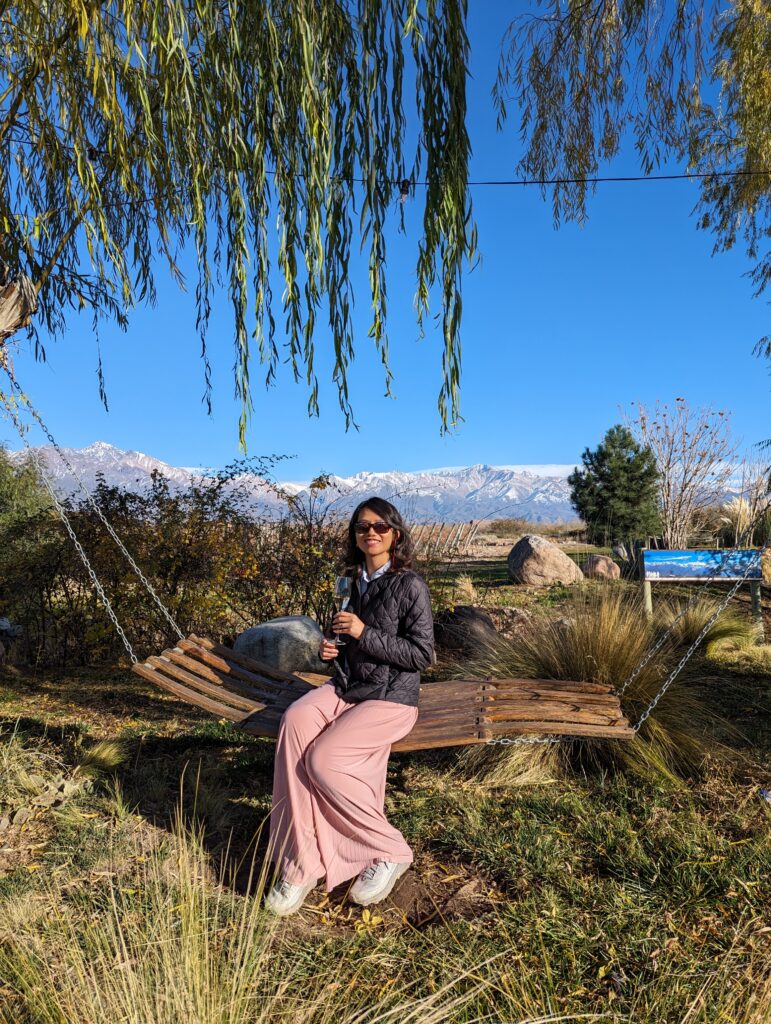
The second bodega, Piedra Negra, was founded by Jacques et François Lurton, two French brothers. Today, François is probably the only owner, he often visits but lives in France. We tasted a pinot gris, which comes from a mutation, giving the wine a cloudy colour. They planted pinot, thinking they were planting chardonnay. They also planted some cabernet sauvignon. Concrete tanks are used for red wine, steel tank for white wine. Steal tanks are 40,000 litres. The production of the estate is 1.4 million litres a year. In the cellar, the barrels are made of oak from France, and used up to three times. Amphoras and eggs are used as well for cheaper wines. People from the tour bought several bottles. I am surprised they did not buy anything at the previous stop, which produces way better (and more expensive) wine. Piedra Negra is sold by SAQ (the state monopoly on imported alcohol in Quebec). Everytime we had to ask the guide to do the tour in English as well as in Spanish, but as we were almost the only non spanish speakers we felt a little bit uneasy. In the end we decided to listen to spanish explanations and only ask questions whenever we needed. It worked pretty okay.

We chose to have lunch at Claroscuro, instead of Monteviejo, because it was 30 euros cheaper with stellar reviews. Tomato starters were delicious, and made with delicious tomatoes we could not find in town. The Tomahawk steak was good and unlimited. The selection of wine was very solid. We all ate at the same table. People were incredibly nice. We had warm conversations with our broken Spanish.
Finally, we ended up with a visit of Monteviejo, the most famous winery in the Uco Valley, and one of the most famous in Mendoza. There was no guided tour and tasting. We just ordered the Lindaflor (grand reserve) chardonnay, and enjoyed it on the rooftop. The Andes and the vineyards with the sun is such a delightful setting.
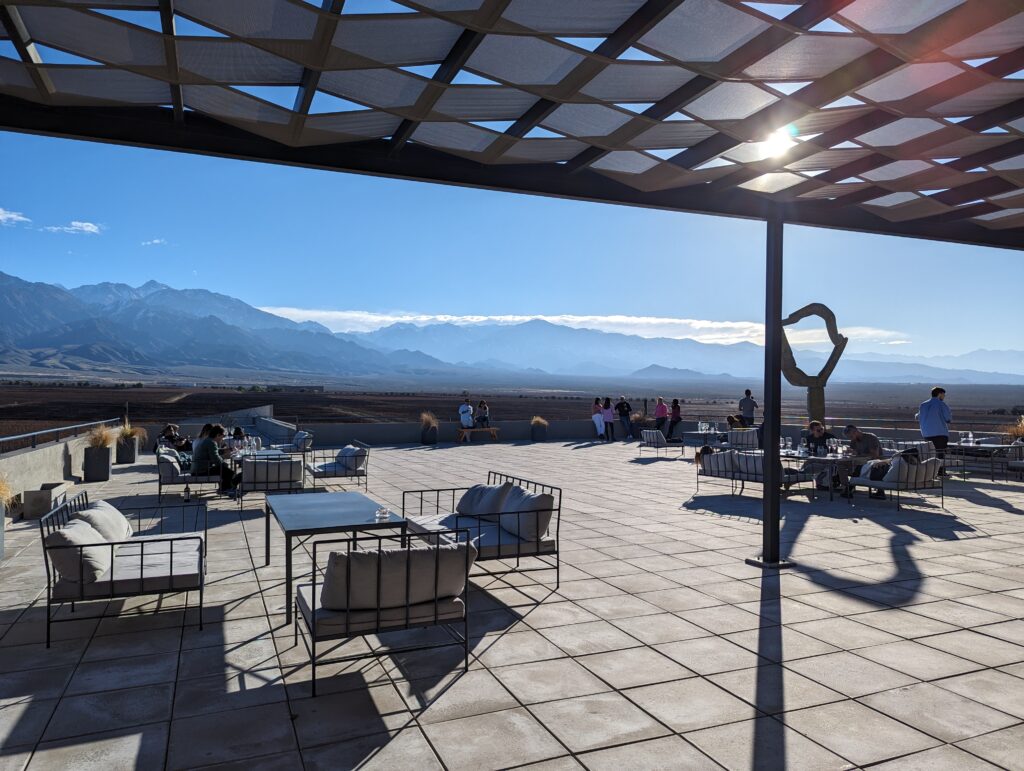
During the day, there was almost no spittoon. People drank their whole glass and more. We were pleasantly surprised not to experience headaches with these good wines. We did throw away the cheaper ones.
Total per person without purchasing any bottle: 38 (the bus) + 18 + 16 + 40 + 9/2 = 116.5k pesos (119 euros with the official rate, around 10 percent less with our credit card, 20 percent less with the Western Union rate).
Sunday, Jun 2, 2024
Walking tour in Mendoza
Most shops are closed on Sunday. The city is very quiet this morning.
We have a private 2-hour free (meaning with tips only) walking tour with Begonia, because other participants did the tour in Spanish. Her English pronunciation is on point. Like most Argentinian in Mendoza, she is from Spanish and Italian descent. Argentinians tend to speak with a lot of hand gestures, like their Italian ancestors. The native population of Mendoza was the Huarpes, who were associated with the Inca Empire.
“Deportation to Chile as industrial labourers contributed to their extinction in the early 18th century.” Britannica.com
Mendoza is an oasis, with minimal precipitations and more than 300 sunny days, because the clouds are blocked by the Andes. Irrigation and aqueducts, bringing water from the Andes, were already in place before the European colonization. Mendoza saw a huge influx of Spanish and Italian immigrants. The many species of trees, which provide much needed shade, are from Europe.
The city experienced a devastating earthquake (6.2 on the Richter scale, the city was probably poorly built) in 1985. The city centre was moved 2 km away from the old centre. Nowadays, constructions are low, rarely exceeding 3 floors, and supposed to be earthquake proof.
We visited Plaza España, Plaza Independencia, and Plaza San Martin. San Martin, El Libertador, is everywhere in Argentina, especially in Mendoza. Avenue San Martin and avenue Colón (a.k.a. Christopher Colombus), which are perpendicular, are the references for every other streets: under the street names, there is the distance (in blocks) to these main avenues.
Plaza de Independencia is large to act as refuge in case of dramatic earthquakes.
Las Abuelas y Los Madres de la Plaza de Mayo, or simply Madres de Plaza de Mayo, is an association created during the last dictatorship to find missing sons and daughters. They wear their children’s diapers (actually a simple piece of fabric, diapers were not the same as today I guess) as headscarves. We see their symbols, a head covered with a diaper, in many places.
The first trial for the crimes committed during the 1973-1983 junta took place in 1985. Argentina, 1985 gave us some insights about the scares left by the dirty war and the recovery process. It was available on Amazon Prime. Many people were killed or disappeared as part of the larger Operation Condor in South America.
On Plaza Espana, the sculptures are supposed to represent fraternity between Spain and Argentina, both represented as female figures. However, Spain looks more mature, literate, and physically dominant. A fresco illustrates Martín Fierro’s literary art about the gauchos, the Latin American cowboys. Another fresco shows Rodrigo de Triana and Christopher Columbus, with an emphasis on the former because he is Spanish. Rodrigo de Triana is the first European to have spotted the Americas, an island in the current Bahamas.
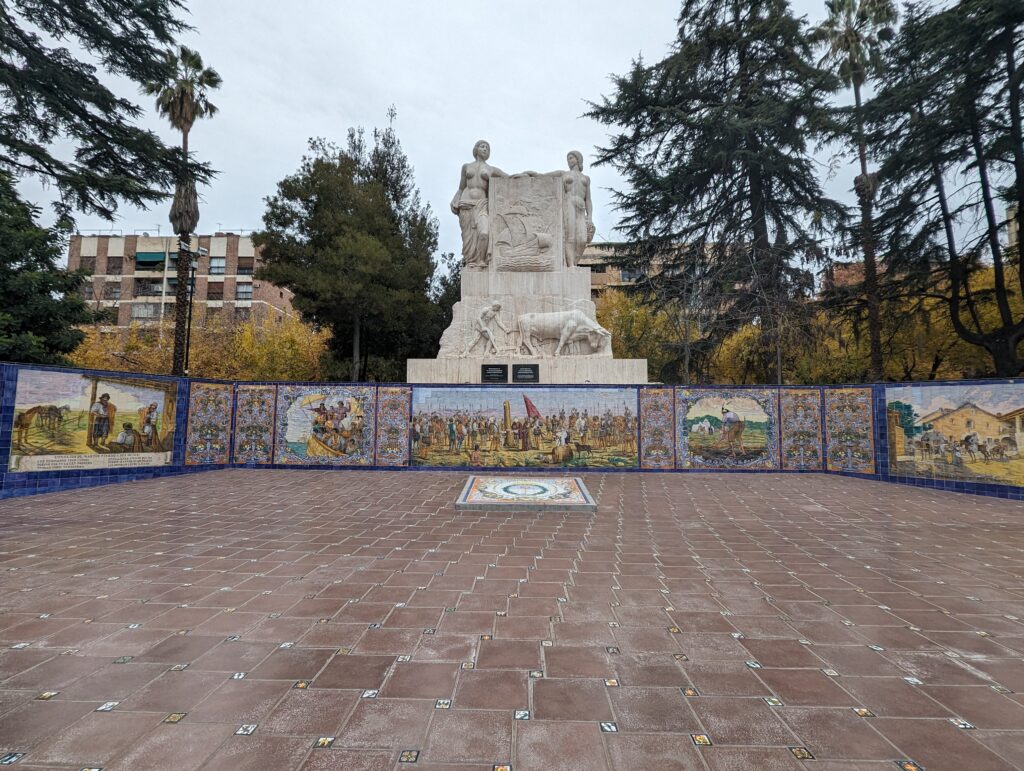
Begonia plays the bandoneon, an instrument created in Germany which resembles an accordion and used in traditional tango. During the performance of the National Orchestra of Argentinean Music, I thought there were accordions, now I think it was probably bandoneons.
In the evening, we went to the concert of Cuarta de Fierro with Julieta Laso from Buenos Aires at the Teatro de Independencia. The tickets were 8 euros for very good seats.
Before the show, we strolled on the Plaza Independencia, looking at the handicraft feria (market) and the water show. Sunday is the biggest day for the market. The water show should be on most days, starting around 7:30 pm.
For concert, take some earplugs just in case, even in classical theatres.
It was a tango concert. Tango bands do not play only for dancers at milongas. Julieta and the singer of Cuarta de Fierro have special and unique voices. A woman was reciting poems in between songs; we saw that in Valparaiso as well. The musicians and singers were incredibly talented. The music was emotional and powerful. The artists talked to the crowd quite a lot and shared their political convictions. The best part is that we did not expect anything from this concert.

Monday, Jun 3, 2024
Wine pairing at Bodega Lopez
We went to Bodega Lopez, accessible by bus from the city centre. There are no vineyard around, we are still in the city. We had lunch with wine pairing. The tomatoes are very good. The beef and goat meat is incredible. The wine is decent for the price. The dessert, consisting of a pear in malbec and spices, served with sparkling wine, was very good as well. Definitely a dessert we would like to reproduce at home. Price: 80k pesos, less than 80 euros.
Supermarket in Argentina are significantly less appealing and stocked than in Chile.
A few payment applications with QR code are launching.
Tuesday, Jun 4, 2024
El Faro Bistro, next to Plaza Espana and Plaza Independencia, has a beautiful rooftop with a view on the Andes. We had some tea with a couple of medialunas.
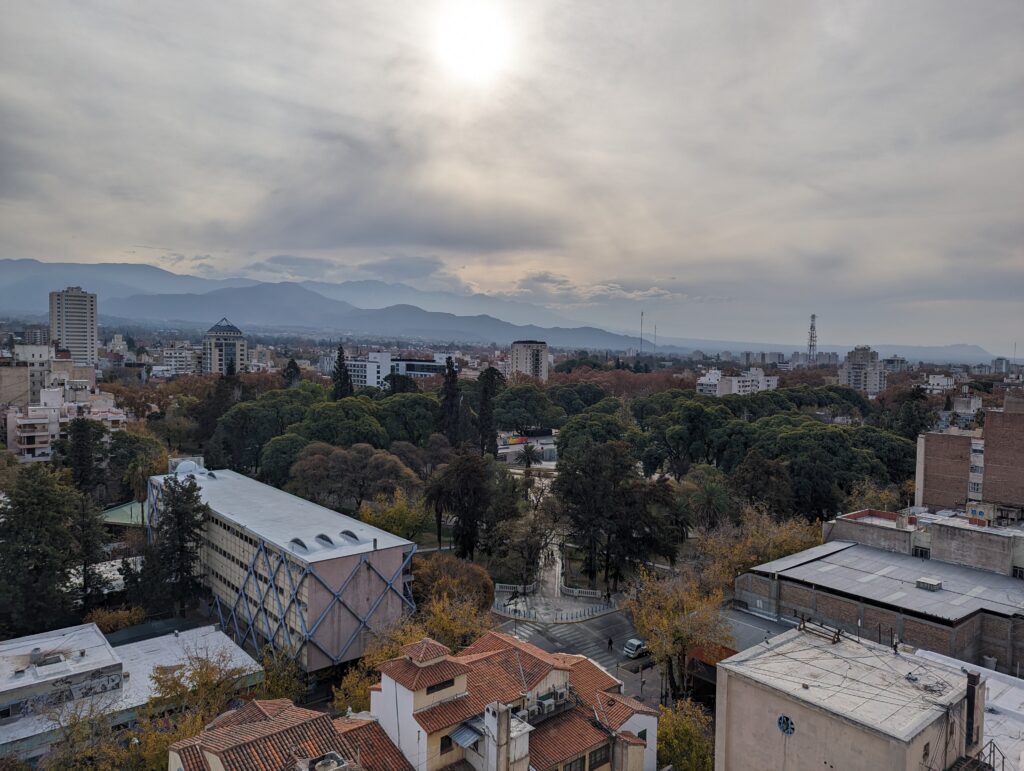
I thought we were going to travel to Brazil and Iguazu by bus, mostly for the planet and secondly for our wallet. The problem is that we feel worn out after long bus trips and need days to fully recover when we don’t fall sick. Once again, we couldn’t buy tickets on the LATAM website (the national company of Chile…) and booked on the phone. We hit the credit card limit, so I had to call back. Then it triggered the automatic security call from the bank, which we resolved quickly.
Wednesday, Jun 5, 2024
Last day in Mendoza
Many arbolitos (street money exchange touts) are at the crossing Av. San Martin and Sarmiento.
The Museo Municipal de Arte Moderno de Mendoza is located under the Plaza Independencia and free. Culture is accessible and affordable in Argentina.
The artist Camila India was working on her series “people’s dark side”, when we visited the museum.
We walked to the Parque General San Martin, and stopped along the way at the Museo Carlos Alonso – Mansión Stoppel, another free museum. The building is nice, but the collection very limited. The park is very pleasant. Many people come to practice sports. Endurance sports are popular.
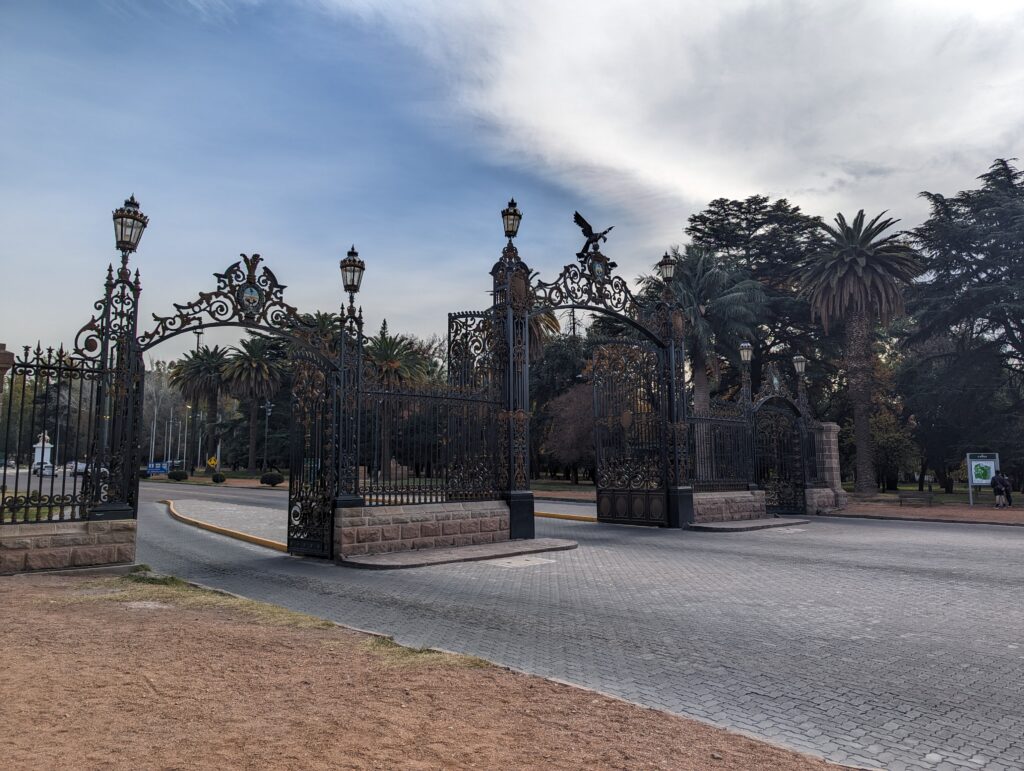
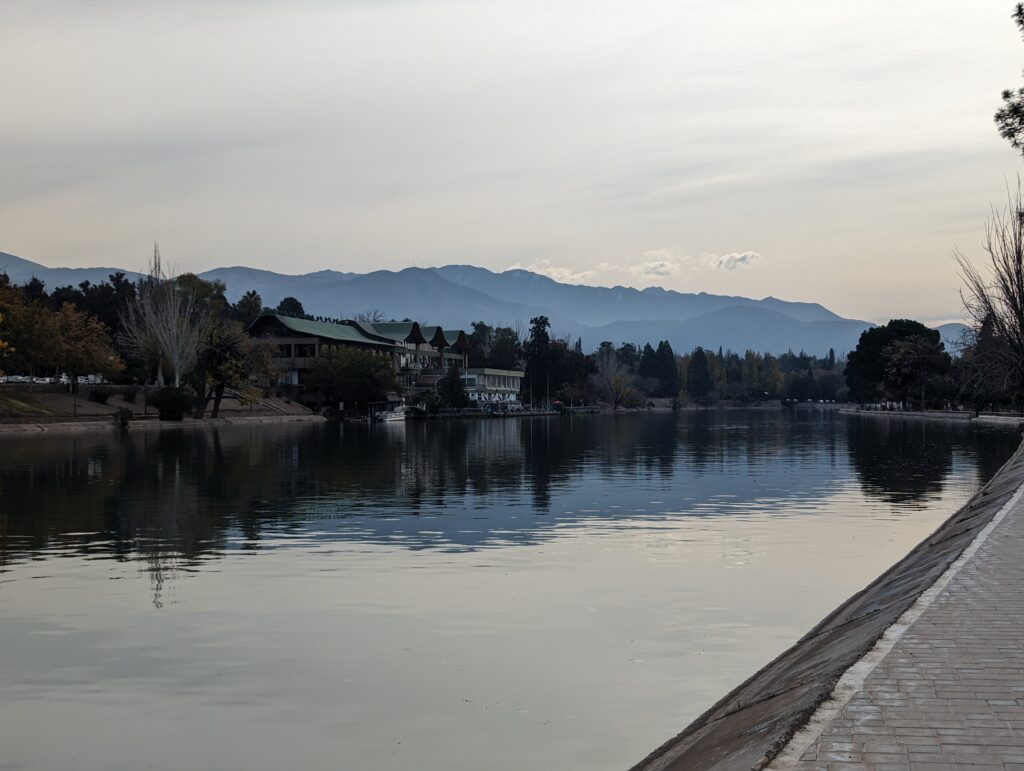
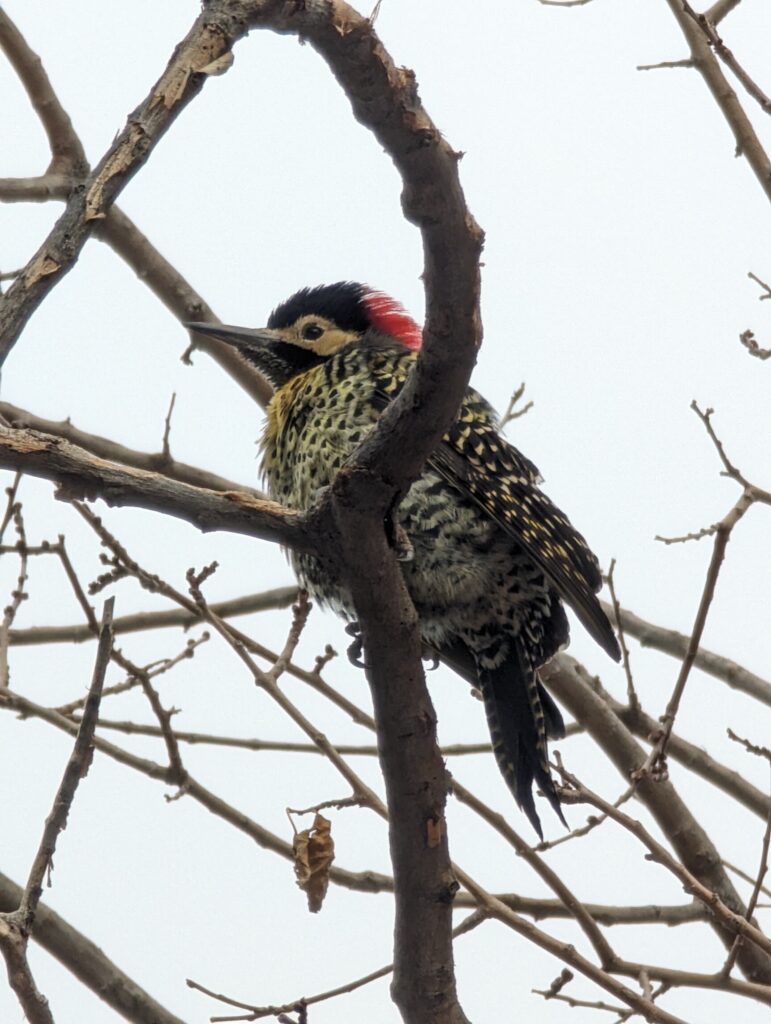
Then, we walked to the Monument to the Army of the Andes at the Cerro de La Gloria. The many commomeration plates illustrate the collaborative nature of the achievement.
The view on the Andes is not the best on the Argentinean side because of the backlighting in the afternoon.
San Martin finished his life in Boulogne Sur Mer in France. Thus, there is a Boulogne Sur Mer street in Mendoza
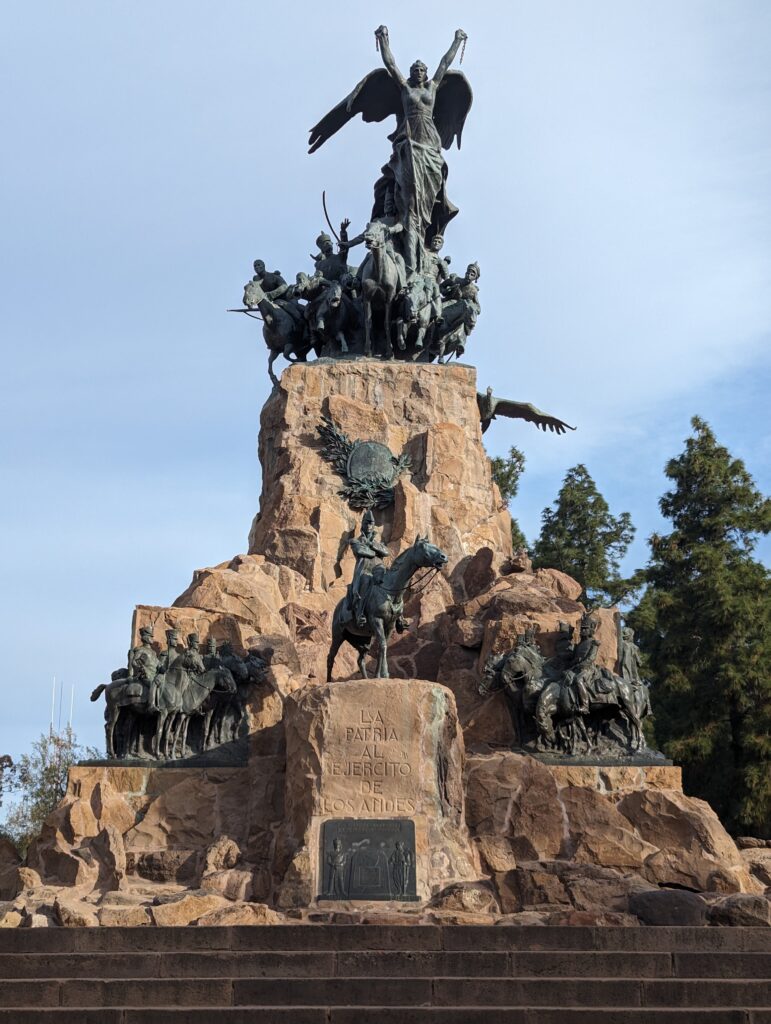
Thursday, Jun 6, 2024
Guided tour in new Córdoba
At the bus terminal, bus companies have ticket offices. Buying tickets there is convenient, and cost-effective because the employees can match online prices and even apply further discounts. It reminds me of the bus terminal in Türkiye! Here we are again with a 10 hours bus…
We did a guided tour with La Docta in the newer part of the city. I thought these guided tours were provided by students, as I read on a blog post. The guide came with two of her friends, all in their thirties and definitely not students. This tour was very average, we probably tipped too much because she was very nice.
Everybody except us drank the mate, sharing the same straw. I am surprised Covid-19 did not change that habit. People made a noise (air going through the straw) to indicate they had finished drinking mate. Then, it was refilled with a huge thermos and passed on to someone else.
Rio (river) Canada was created to prevent floods in the city. We were told that on the other side of Rio Canada, further from the centre, it was less safe for tourists.
Fernet Branca con Coca-Cola is a special cocktail from Mendoza. That night, our neighbours ordered Fernet Branca with Pepsi.



Friday, Jun 7, 2024
Guided tour in antique Córdoba
Yellow duck head clips are sold everywhere on the streets. Is it a trend from Asia or the USA? It seems pretty recent : one month only.
We did the antique tour with La Docta. Once again we bumped into Yu, a Chinese backpacker that we saw in the South of Chile, Easter Island and here on this tour! She was this time with a Korean traveler. Thomas, the guide, was a unique character. Córdoba was founded by Jerónimo Luis de Cabrera, a conquistador executed one year later for insubordination to the viceroy. During the Spanish rule, Plaza San Martín was named Plaza Mayor. The cathedral and the Cabildo are on that place. The cathedral construction took almost two centuries. Construction skills were missing when the colony was founded. The painter Emilio Caraffa made some improvements in the 20th century. The Cabildo was the government of the city under the Spanish reign.
The Granaderos a Caballo was a regiment formed in 1812 which fought under San Martín. A lomito is a sandwich with young cow meat.
Empanada folding (repulgue in Spanish) can indicate the type of empanada and the region. Asado and milaneza are popular meat dishes.
Argentinians have four meals a day, including merienda, a kind of British tea.
When people sneeze, you can say “Salud”, then “Dinero”, and finally “Amor”.
Removing the bombilla (the straw) from the mate ruins the mate preparation. Mate is often served with facturas, also called criollitos or pan criollo.
Alfajores are different in Cordaba, they are covered with chocolate or icing sugar.
The “U” is not pronounced, except with a diaeresis, for instance in “pengüino”.
“Cuarteto” is a music genre born in the city.
Rafael Núñez is a famous politician born in Cordoba. He was the viceroy during the British invasion 1806 and run away from Buenos Aires (BA) to Cordoba (CDB).
The 20k banknotes (20 euros) are supposed to come in November.
Córdoba is nicknamed La Docta (the knowledgeable) because of its many universities built by the Jesuits. Salta is nicknamed La Linda.
The graduation ritual after the last exam is peculiar in Argentina. Students are wearing only underwear, and friends and relative through all kind of colourful substances at them.

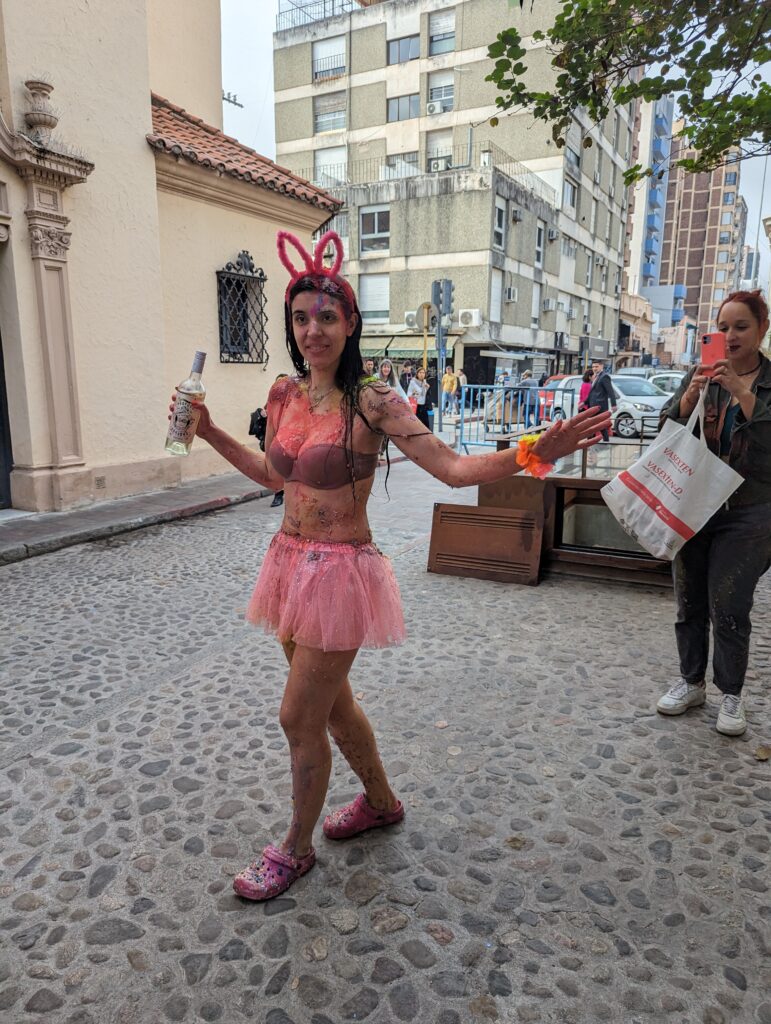
The Patio Olmos is a school that has been converted to a shopping mall. I bought a shirt there. Clothes are stylish. Almost all shops offer to purchase with multiple payments without interests. Given the high inflation, it is generous. Purchasing power seems to be limited. But you can get a discount if you buy with a single payment.
We went lunched with Yu and her friend and learnt that he was formerly a soldier and went to the US to study as a pilote. We are unsure why, but he did not get the job and is going back to Korea where he would not be employed with a foreign degree…
Bici CBA is the free bike sharing system. We really enjoyed riding these bikes round Parque Sarmiento and the long white footbridges.
Very few big supermarkets in the city centre. It is not the first time I see very long queues (sometimes stretching the entire floor) in supermarkets. Too few cashiers?
Saturday, Jun 8, 2024
Last day in Córdoba
After passing by the Manzana Jesuítica (Jesuit Block) several times, we decided to explore it more in depth. I wish we could have done that with the free walking tour. Many museums are closed during the weekend, so we could not do everything we wanted. We paid the entrance (1.5k pesos) of the Museo Histórico de la Facultad de Derecho — unlike most people —, so the guard opened the graduation hall for us.

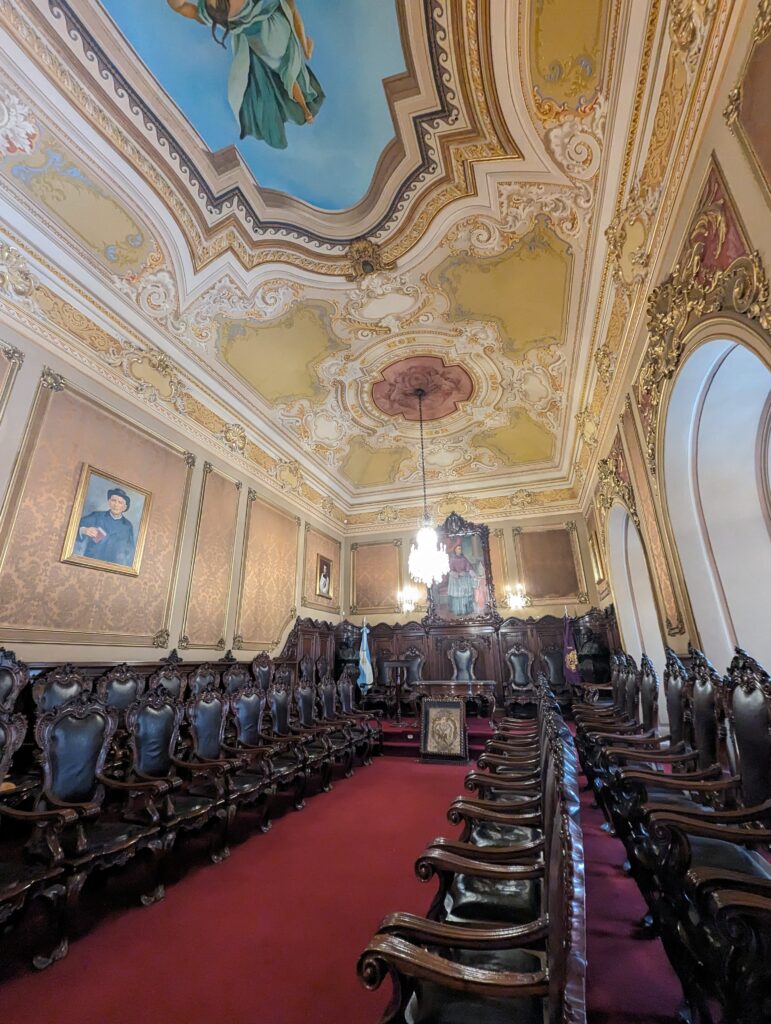
We had lunch at La Vieja Esquina, and enjoyed the criollas (creole) empanadas and the humita (pre-hispanic soup/paste of corn, onion, pumpkin, and spice). We had to queue to get in, but luckily they closed just behind us at 2PM.

Walking down Belgrano Street in the hipster district of Güemes, we looked for the flea market. It was closing when we got there.
The Museo Superior de Bellas Artes Evita in the Palacio Ferreyra cost 1k pesos (1 euro) per person. The building is beautiful, given the low entry fee, it is worth it.
For dinner, we came back to La Vieja Esquina to taste the rest of the menu. The locro was really good. Y could not resist scooping out most of the oil.

Sunday, Jun 9, 2024
From Córdoba to Tucumán (San Miguel de Tucumán, to be complete) by bus.
The bus terminal of Córdoba is home to many homeless people. Here we are with another 11 hours bus.The bus final destination is touching the Bolivian border. Some people seem equipped to spend the night. We arrive in Tucumán late at night.
Monday, Jun 10, 2024
A day in Tucumán
The streets in the center of Tucumán are bordered with orange trees full of fruits. We were wondering if we could pick some of them up. It turned out you can, but the oranges are very acid, and people use them to make jam. We made some “lemonade” out of them.
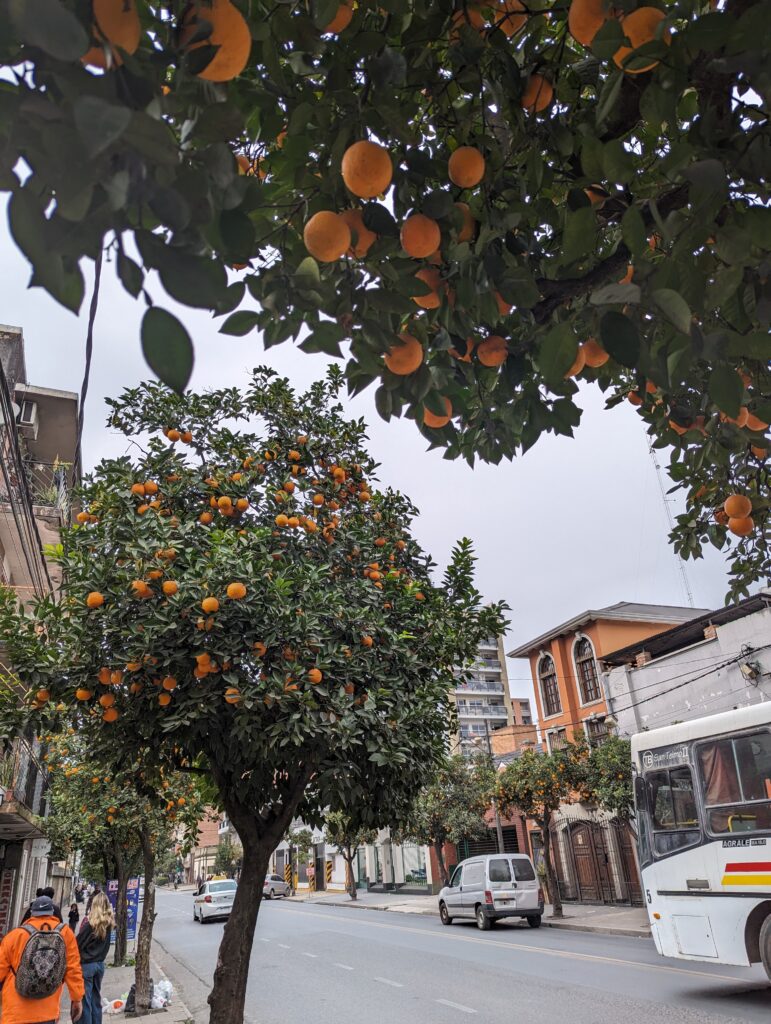
To eat more veggies, a vegetarian restaurant is an excellent choice. We really needed that vegetarian buffet at Shitake.
We had a guided tour of the governor office (Casa de Gobierno) by the official translator of the governor. Just the two of us since nobody else showed up. The old lady was bright, and funny. We did the tour in Spanish even if she could do it in English. We want to practice and it turned out we could get most of it.
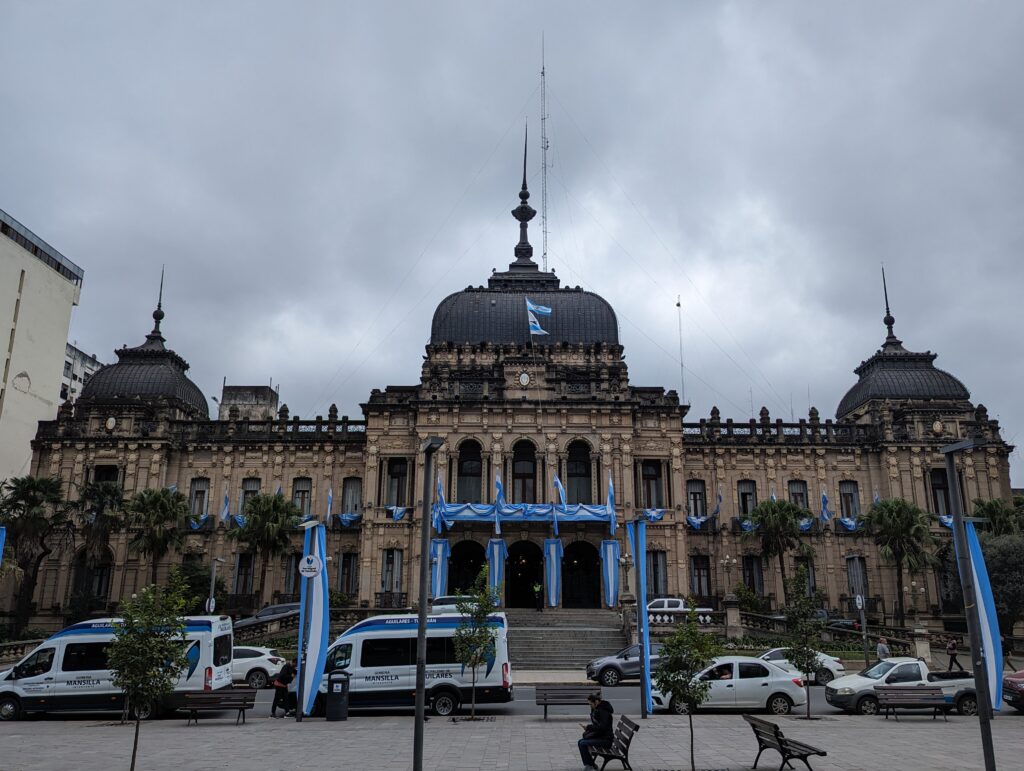
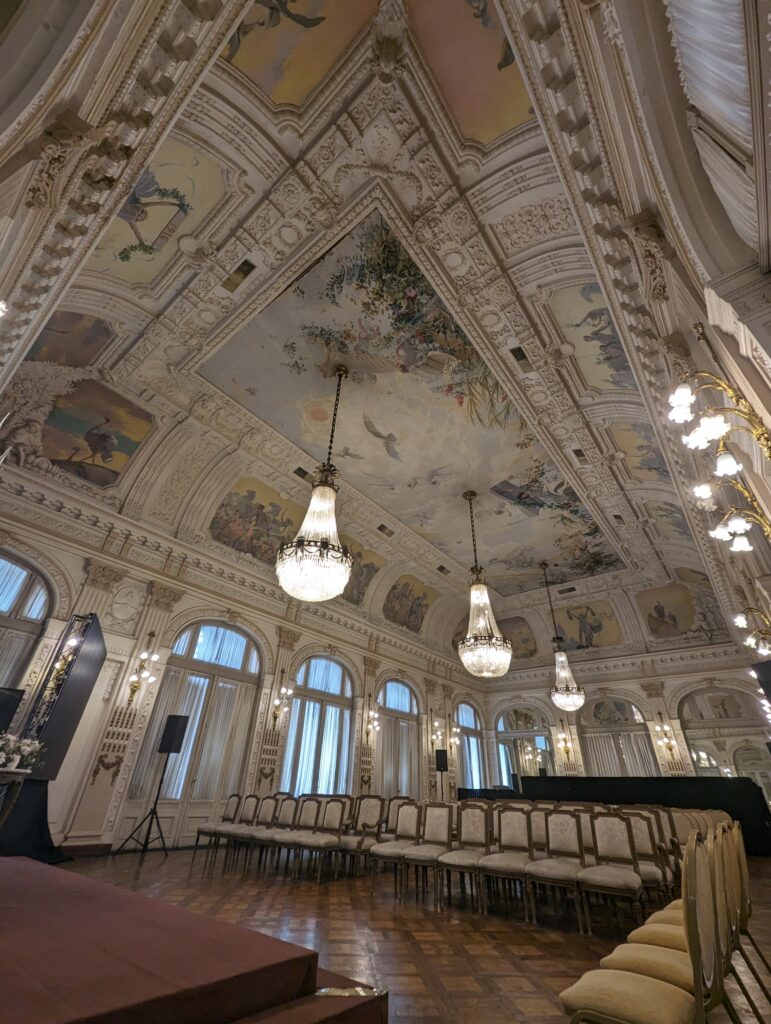
Then, we headed to la Casa Histórica, an independence museum, where the independence of Argentina (more precisely the United Provinces of South America) was signed on July 9, 1816. The war of independence began in
May 25, 1810, when a local government took over the Spanish viceroy in Buenos Aires.
For some time, Argentina was used by the Spanish to support the mining industry. The Cerro Rico in Potosi, Bolivia, was the richest source of silver in history. It provided 80% of the world production of silver (“plata” in Spanish) between the 16th and 18th century. Workers were mostly Amerindians; there was black slaves as well. The death toll is horrifying (at most eight million miners). “La montaña que come hombres.”
During the War of Independence, General Belgrano successfully battled in Tucumán against loyalist troops with fewer men and mostly non-professional soldiers.
The Cruze de los Andes, San Martin crossing the Andes to kick the Spanish out of South America, began just after the independence of Argentina and ended in 1822.
The USA constitution inspired the Argentinian constitution, both federal states.
The original declaration of independence went missing shortly after it was signed. There were 1500 copies printed and distributed at the time.
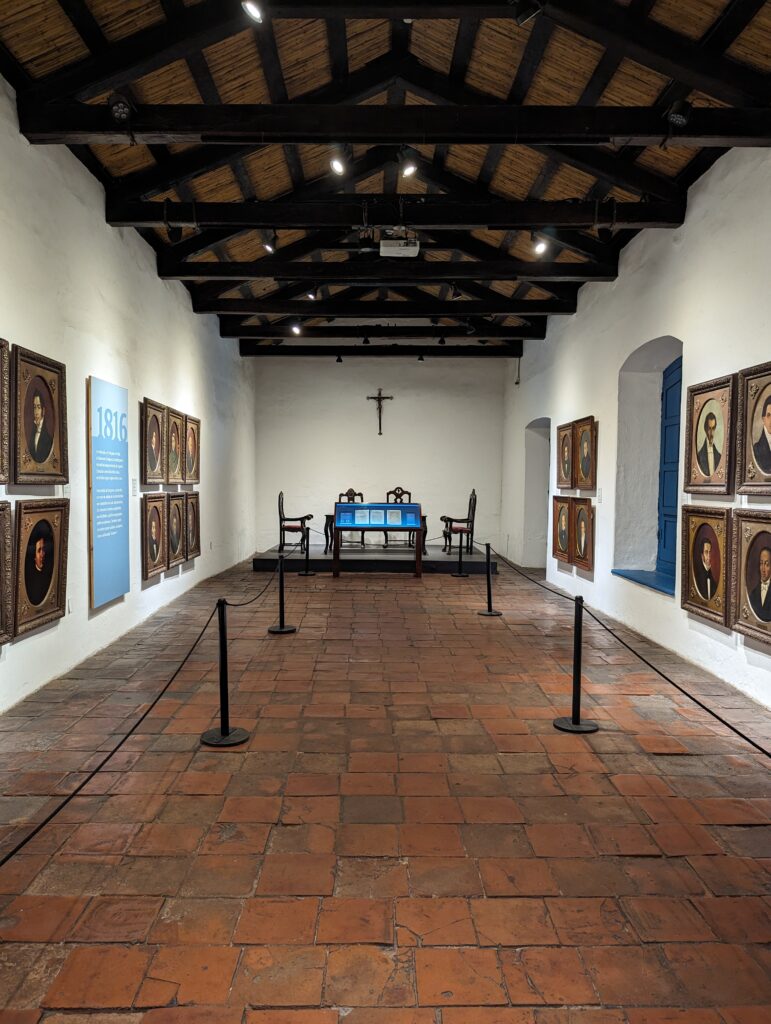
Tuesday, Jun 11, 2024
Another day in Tucumán
We visited several museums and churches in the city centre. It was pleasant, but I’ll forget these visits for sure.
Tomorrow, we go to Salta. Just 4 hours bus this time!
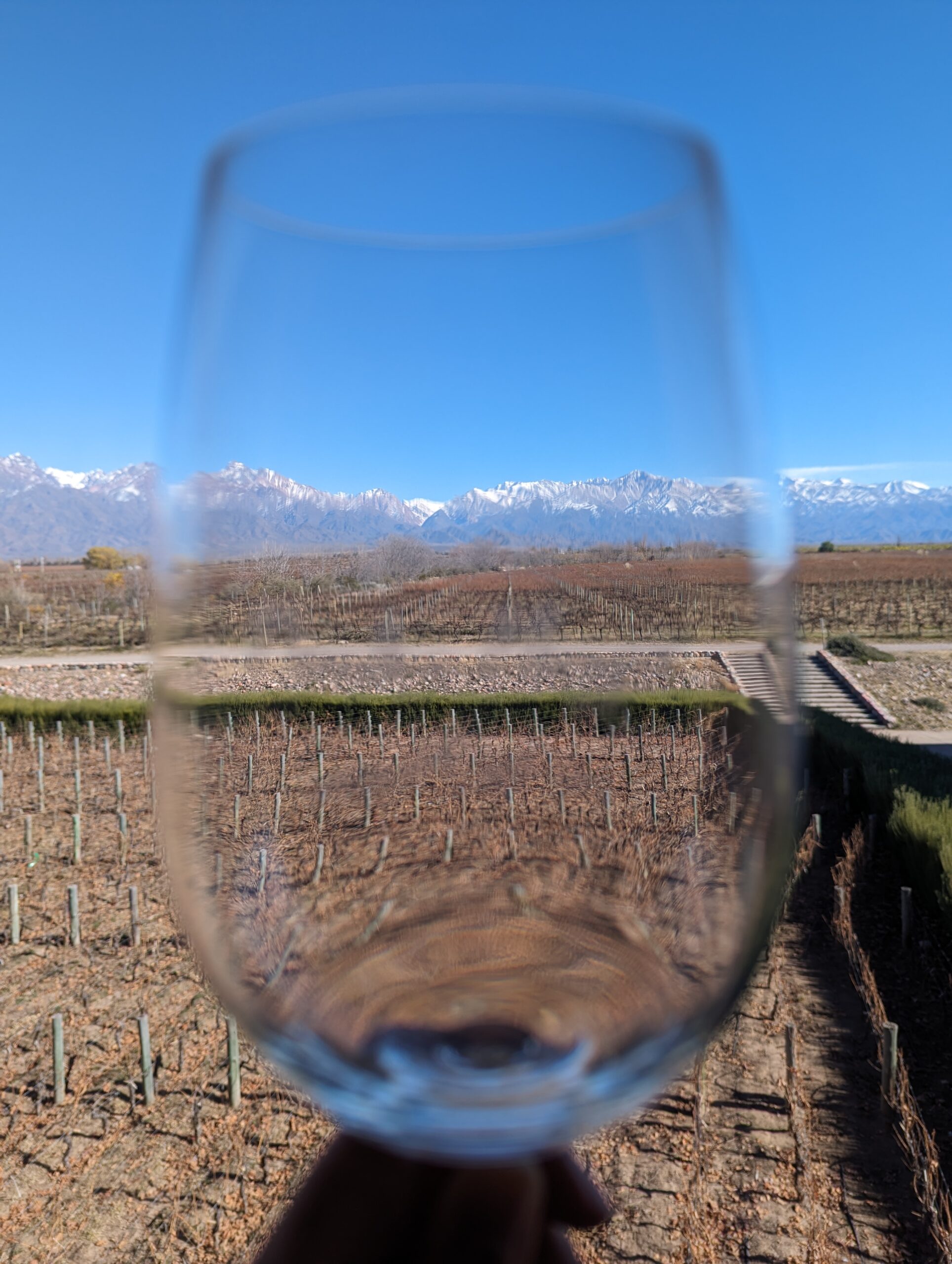
Leave a Reply